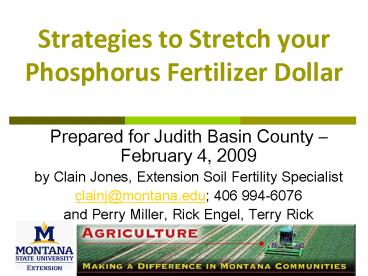Strategies to Stretch your Phosphorus Fertilizer Dollar - PowerPoint PPT Presentation
1 / 30
Title:
Strategies to Stretch your Phosphorus Fertilizer Dollar
Description:
Strategies to Stretch your Phosphorus Fertilizer Dollar ... Determining P Application Rate (from EB 161) From Fertilizer Guidelines for Montana Crops (EB 161) ... – PowerPoint PPT presentation
Number of Views:122
Avg rating:3.0/5.0
Title: Strategies to Stretch your Phosphorus Fertilizer Dollar
1
Strategies to Stretch your Phosphorus Fertilizer
Dollar
- Prepared for Judith Basin County February 4,
2009 - by Clain Jones, Extension Soil Fertility
Specialist - clainj_at_montana.edu 406 994-6076
- and Perry Miller, Rick Engel, Terry Rick
2
What do you grow?
- Forages?
- Small Grains?
- Others?
3
Objectives
- Show phosphorus cycle and relevance
- Discuss
- - Rates
- - Source Liquid vs Granular vs Avail
- - Placement
- - Timing
- - Previous Crop Effects
4
What are P losses?
P Cycle
5
- Soluble P concentrations in soil are generally
very low (0.01 0.1 parts per million) due to - Precipitation of poorly soluble calcium phosphate
minerals. This is very relevant in this regions
high pH, calcareous soils. - 2. Strong sorption to manganese, aluminum, and
iron oxides and hydroxides (example rust). This
process increases at low pH so is only an issue
in small areas of Montana.
At what pH levels would you likely need to
fertilize with more P?
6
If you want more information on P cycling, go to
MSU Extensions publication at
http//www.montana.edu/wwwpb/pubs/mt44494.pdf
7
Determining P Application Rate (from EB 161)
- Sufficiency Approach Do you want to apply
minimum necessary to maximize yield in most
years? If so, use Table 18 (P). - Maintenance Approach Do you want to replace the
nutrients removed at harvest? If so, use Table
21. - Build Approach Do you want to build your soil
P, to minimize yield losses and save on
fertilizer in future years? If so, add amounts
from 1 and 2.
What might your answer depend upon?
8
Rate
From Fertilizer Guidelines for Montana Crops (EB
161)
9
(No Transcript)
10
P Source options
- Monoammonium P (MAP)
- Diammonium P (DAP)
- Liquids (generally more expensive than MAP and
DAP) - Generally no yield differences between sources.
- Exception Liquids can produce higher yields on
highly calcareous soils (gt 20 CaCO3) - Avail by Specialty Fertilizer Products An
Enhanced Efficiency Fertilizer - Limited work done on Avail for cereals in the
western U.S. (none on SFPs website)
11
Placement Banding vs Broadcast
Banding P is much more effective than banding N,
because P is much more immobile in the soil.
12
Effect of P banding depth on winter wheat grain
yield
McConnell et al. 1996
13
Effect of P banding depth on small grains
14
Vertical Olsen P Distribution at Moccasin
Jones and Chen, Moccasin, Sept. 2005
What problem(s) do you see with high Olsen P near
surface?
15
How do localized concentrations of nutrients
affect root distribution?
(Drew, 1975)
16
QUESTIONS?
17
Timing
- Ideally we would apply P directly to the root
zone right before peak P uptake - Not practical, so best to apply P at time of
seeding (with or below seed) - On pastures, P responses are better with Fall
application. Why? - Value of Foliar P?
18
Effect of Foliar P on Winter Wheat Grain Yield
19
Questions so far?
20
Does crop rotation and/or previous crop affect P
availability?
21
Bozeman Crop Diversification Rotation Study (CDRS)
- Study initiated at Agronomy Post Farm in 2000 (6
miles west of Bozeman) - 17 treatments with 4 year rotations (4 reps)
- 1 organic (ORG) rotation (no inputs). N
fertility one winter pea green manure and one
lentil rotation (harvested for grain) - 1 pesticide free production (PFP) rotation
- 8 fertilized no-till/fertilized rotations
including winter wheat based (NTW) and diverse
(NTD) with both low (L) and high (H) N rates.
22
CDRS Olsen P Comparison Top 6 inches (March
2007)
23
Crop species that can help dissolve phosphorus
minerals
- Buckwheat Legumes Some Mustards
24
Question Can green manures help dissolve rock
phosphate fertilizer to increase organic winter
wheat grain yields in Montana?
25
Methods
- Location Organic small grain farm, Big Sandy, MT
- History Managed organically with intermittent
legume green manures for 21 years. No inputs. - Upper 6 inch soil pH 6.6
- Upper 6 inch Olsen P 16.1 ppm
26
Methods
- First Year (2006) Crop Treatments
- Buckwheat (Mancan) Yellow Mustard (AC
Base) Spring pea (Arvika) - Fallow
- April 2006 Broadcast-Incorporated RP (0-2.1-0)
Treatments 0, 7, 17 lb available P2O5/ac - Second Year Crop Winter wheat (Tiber)
27
Big Sandy Green Manure Study
28
Effect of green manure crop and rock phosphate on
subsequent winter wheat grain yield, Big Sandy
2007
3.3 bu/ac yield increase between 0 and 17 lb
P2O5/ac when averaged over previous crop tmt
29
Summary
- Optimizing P use is important especially in times
of high P fertilizer costs. - Rates will vary depending on your goal
(sufficiency, maintenance, or build) - Banding is more efficient than broadcast P
- P is most effective when applied at time of
seeding - Foliar P may slightly increase yield, but likely
not worth it. - Although some crops can dissolve P minerals, the
effect doesnt appear to transfer to the next
crop.
30
For more Information
- Soil Fertility Website http//landresources.monta
na.edu/soilfertility
Questions?































